2013 Chevrolet Camaro ZL1 Convertible vs. 2012 BMW M6 Convertible
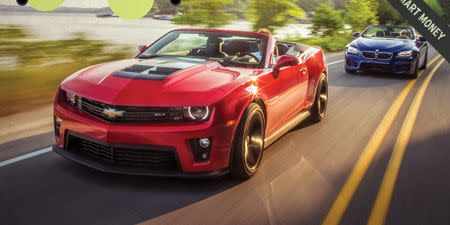
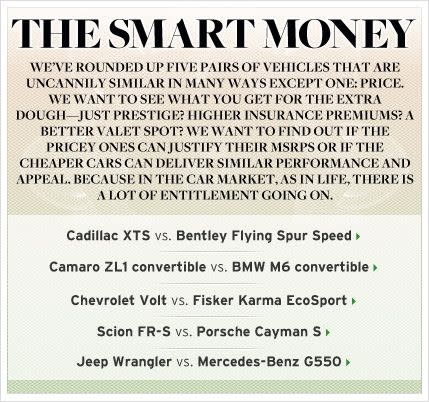


In our world, BMW M6 and Chevy Camaro ZL1 owners buy these cars because they are going to use them. And not just use them, but use every last horsepower and g of capability. We admit that we do not live in the real world. While some owners actually track and race their M6s and ZL1s, many others use them almost exclusively for phallic demonstration. For these buyers, convertibles hold a big advantage. Liberating experiential factors aside, preening is one of the big benefits of convertibles over coupes. People tend to notice cars like an M6 or a ZL1; people tend to notice the driver of the equivalent convertible.
But why these two, here, together? Because aside from their highly divergent sticker prices, these two are like members of a common species whose evolution was separated by an ocean. The M6 and the ZL1 are both sedan-based, rear-drive, four-seat droptops powered by blown V-8s; one a very German take on the concept, the other quintessentially American. Both live to display.

If the goal is showmanship, then the M6 seen here arrived in the appropriate hue. BMW calls it San Marino Blue Metallic, but we’d have gone with peacock blue. Returning to market after a brief respite, the M6 convertible equips its driver well for chest puffery. Gone is the 8250-rpm V-10, but in your moment of despair, reflect on this: The twin-turbo V-8 that replaces it, while of a less exotic construction, tops the 10’s output by 60 horsepower and 117 pound-feet of torque, for totals of 560 and 500, respectively. This new M6 wears far more graceful sheetmetal than did the previous car, and its interior is so overrun with leather that you’ll even find cowhide in the door pockets. And at $115,295 ($125,595 as tested), the M6 is some pricey peafowl.
By pairing it with the Camaro ZL1 convertible—base price, $61,745—we aim to see how much of the M6’s strut can be had for less. Much less. As tested, the ZL1 costs $552.50 less than half of the M6’s sticker. With a splitter skimming just above the pavement, its carbon-fiber hood bulge vented to cool the engine room, and matte-black rims scowling from the wheel wells, the ZL1’s plumage is permanently fanned. It’s within three inches of the BMW in all critical dimensions, seats four, and even has a matching cloth top. Its LSA V-8, a derivative of the supercharged mill powering the Corvette ZR1, betters the M6’s output—with 580 horses—and crushes its twist with a 56-pound-foot advantage. Our ZL1’s color? Victory Red. Rather presumptuous, but that’s the peacock way.
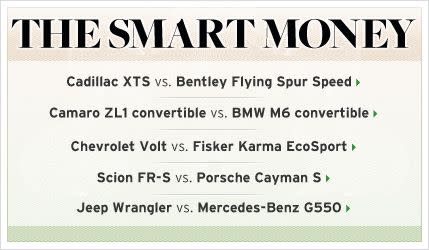
While looking for ways to stretch the peacock metaphor beyond the bounds of good taste, we came across an ad informing us that peacocks discourage snakes. “Hey, snake, you’re never going to amount to anything. You don’t even have arms or legs! Why don’t you just crawl into a hole in the ground?” Our experience with the M6 heaped similar disparagement on the ZL1. The BMW is the better car by nearly every measure. Its structure feels far stiffer than the Camaro’s shell, immediately imparting a superior sense of driver control. Top up, the M6 provides a more serene experience, with great noise insulation and nary a ruffle from the fabric. The leather-wrapped everything inside the BMW feels at least four times richer than the ZL1’s interior trimmings. At 4506 pounds, the M6 is slightly heavier than the ZL1, but whatever mass was spent stiffening the structure and quelling noise was well worth it.
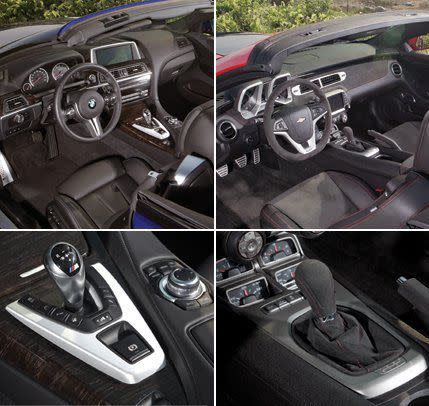
That the 4.4-liter twin-turbo V-8 so easily shrugs off its burden also makes those pounds easy to forgive. Here we have a Camaro with 580 horsepower competing against a car that waltzes away from it—despite hauling more weight with less horsepower. We didn’t see that coming. The BMW hits 60 mph in four seconds flat—0.4 ahead of the Chevy—and holds that advantage through the quarter-mile, which takes just 12.3 seconds. From that point on, the window only opens farther as the quick-shifting dual-clutch automatic keeps the power flooding rearward uninterrupted. In its softer settings, the transmission is so fluid that we found ourselves trying to shift into eighth gear, forgetting that this isn’t the 650i’s automatic.
The ZL1 handily beat the M6 on the skidpad, 0.97 g versus 0.92, but the BMW took the slalom honors. Credit the suspension tuning enabled by its more rigid structure and consequent body-control advantage. At its limit, the M6 feels vastly lighter than it is and maintains an immediacy and balance superior to the ZL1’s. We dropped in to an open-track night at GingerMan Raceway in South Haven, Michigan, and after one lapping session, technical editor K.C. Colwell called the BMW a “drift maestro.” At the end of GingerMan’s straightaway, we saw speeds in the low 120s in the Camaro. The M6’s speedometer readings at that point were about 10 mph higher.
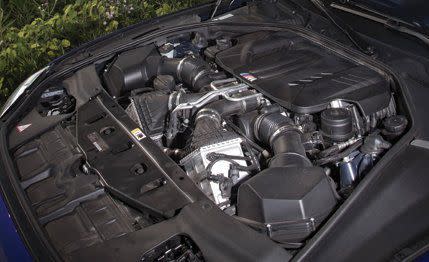
Similar to many modern German cars, the M6 achieves what it does through sheer technological force of will. The downside to this is that the driver glimpses perhaps too much of the car’s complexity. The stability control, throttle map, damping, steering, and transmission each have three settings, for a total of 243 different combos. Buttons for each of these parameters abut the shifter. Don’t even control freaks sometimes just want to get in and drive, without having to issue all of those commands? Thankfully, most people’s perfect combos for both cruising and maximum attack are in there somewhere, and the two memory buttons on the steering wheel recall your recipes with the push of one button instead of three pushes each of five.
So why did the M6 finish second? The BMW does most everything better. But the ZL1 has more than half the swagger at just less than half the price.


In almost everything it does—even sitting in a parking slot, ignition off—the Camaro is loud. It reminds us of Jacob Silj, Will Ferrell’s noise-immodulated Saturday Night Live character, who is incapable of lowering his voice below a yell. The Camaro is impossible to ignore, whether you’re looking at it or riding in it. In traffic, where the BMW faded into the background in spite of its brilliant paint job, people hung out of windows, snapped pictures, and even high-fived each other when they saw the ZL1. (“Dude, you totally saw that thing!”) Over bumpy roads, cowl shake subs in for steering feel, sending quivers up the column that say nothing about lateral loading but plenty regarding road-surface quality. There’s so much noise that passing trucks had us reflexively clicking the switches to make sure the windows were up. They were. Lower them, and the Camaro’s backlight flaps violently in the wind. Compare this level of refinement to the M6, which has a power rear window that can be independently lowered and allows zero cabin disturbance when down (at 80 mph, we had to point out to passengers that we had lowered it). The ZL1 is not a relaxation chamber.
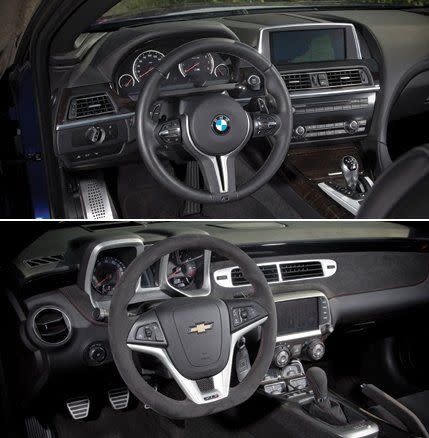
And yet it’s the better long-hauler and the simpler one. As opposed to the M6’s overwhelming menu of settings, the Camaro offers two: tour and sport. Tour is comfortable; sport is firm. Both do their jobs well, and we appreciate the straightforwardness of the Chevy approach. Even in their softest setting, the M6’s shocks can’t match the cushiness of the Camaro’s magnetorheological dampers. On roads without the sort of high-frequency bumps that harmonize in the Chevy’s shaky bits, it’s the smoother cruiser of the two, better soaking up individual impacts. And its wide, soft seats don’t provide the same support as the BMW’s on track but are the preferable buckets for long stints. If you’re readying for a road trip, though, brace yourself: The Chevy is thirstier, burning a gallon of premium every 16 miles as opposed to the BMW’s 19. Around GingerMan, those figures fell to 5 and 7 mpg, respectively.
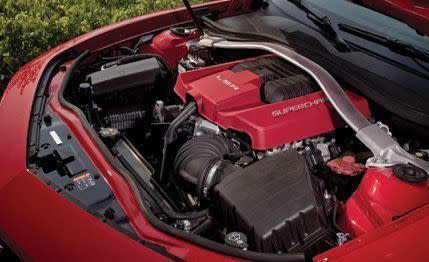
The ZL1 gets better and feels smaller the harder you push it. At lower speeds, the steering is light on feedback and a little overboosted, but it weights up nicely at higher velocities and gets heavier still if you push the sport-mode button. With more than a ton of weight carried by the rear axle and a foot-wide contact patch at each corner, the tail’s stick is incredible, especially considering the power being funneled through it. Even so, the M6 shows greater poise and agility at the limit. We pitied the ZL1’s “outside” front tire, whereas the M6’s shares its load with the rest and feels less nose-heavy.
The ZL1’s greatest joy is its LSA supercharged V-8. Every combustion stroke is a chest thump, and the quad tailpipes bellow a rally cry for redline shifts. The heavy, snappy clutch feels appropriate. In comparison, the BMW’s synthesized warp-drive soundtrack is just weird. Thanks to its boisterous engine and clutch calibration, driving the ZL1 feels like more of an event. The M6 isn’t engaging until you’re flat-out, when its superb balance (for such a big, heavy car) reveals itself. The ZL1 is always engaging, if for no other reason than the exhaust roar drowns out all thoughts except a Jacob Silj–like Now we’re going faster! BMW builds a fine car, but for mere bantam-rooster money, the Camaro is the better peacock.
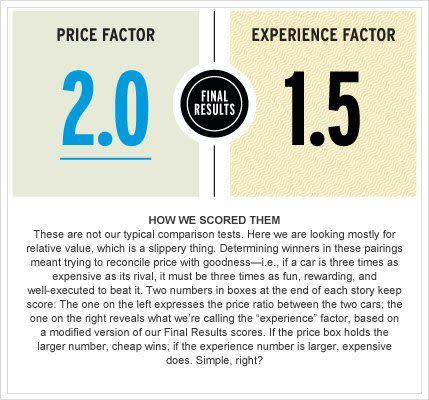
You Might Also Like

 Yahoo Autos
Yahoo Autos 